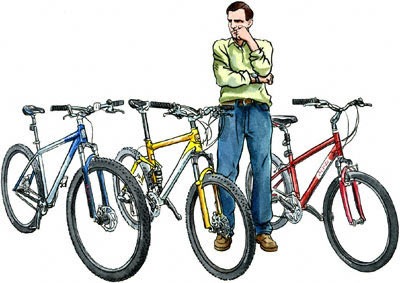Bike Size Charts And Sizing Guide

This Guide Will Help You Pick The Correct Size Bike For You As Well As The Best Style.
When trying to decide on the best type of bike for you, thinking about these questions will help:
- What size bike do I need?
- What type of bicycle do my friends ride?
- Where do you plan to ride your bicycle?
- What have you ridden in the past that you liked?
- What have you ridden before that you disliked?
- How much money are you comfortable spending?
- Do you tend to buy the highest-tech cutting-edge products or do you go for good value?
Answering these questions to the best of your knowledge will help simplify the bike picking process!

By: Matt Donovan,
3rd generation Owner and General Manager of Dedham Bike
Last updated: 8/5/23
What Size Bike Do I Need?
Getting the right bike size is very important when out shopping for a new bicycle. Proper stand over height, saddle height and reach to the handlebars are of the utmost importance for safety as well as comfort.
Bike size charts
Use this general sizing chart to help you decide which is the best size for your height. It is a basic guide but does the trick for most folks to help you decide on frame sizing.
| Rider Height | Bike Size |
| 4’ 11” – 5’ 3” | 13" – 15" (XS/SM) or 48 - 52cm |
| 5’ 3” – 5’ 7” | 15" – 17" (SM/MD) or 50 - 54cm |
| 5’ 7” – 5’ 11” | 17" – 19" (MD/LG) or 54 - 57cm |
| 6’ 0” – 6’ 2” | 19" – 21" (LG/XL) or 58 - 61cm |
| 6’ 2” – 6’ 4” | 21" – 23" (XL/XXL) or 61 - 62cm |
| 6’ 4” + | 23" - 25" (XXL) or 63cm Plus |
Of course this can be broken down even more by bicycle styles and intended use (ie: mountain vs. road etc.)
What Size Mountain Bike Do I Need?
Sizing a mountain bike is different than any other bike due it's different geometry and intended use. This mountain bike sizing guide will help direct you towards the right size for you based on your height.
Mountain bike size chart
| Rider Height | Bike Frame Size |
| 4`10”-5`1” | 13” to 16" or XS to SM |
| 5`1"-5`5" | 16" to 17" or S to MD |
| 5`5"-5`9" | 17 to 18"” or M to M/L |
| 5`10"-6`0" | 18" to 19" or M/L to L |
| 6`0"-6`3" | 19" to 21" or L to XL |
| 6`1"-6`6" | 21" to 23" or XL to XXL |
Sizing does vary slightly from brand to brand so these numbers are not set in stone but are fairly solid.
What Size Road Bike Do I Need?
Sizing a road bike varies from mountain or hybrid. Generally centimeters are used to measure road bikes where inches are the preferred way of the bicycle brands of measuring hybrids and mountain bikes. Road bikes are available in more sizes as well. Most riders are able to ride 2 frame sizes comfortably with minor adjustments. Some brands have started measuring frames in s/m/l/xl/xxl for simplicity.
Road bike size chart
| Rider Height | Bike Frame Size |
| 4`10”-5`0” | 47 - 50cm or XS |
| 5`0"-5`3" | 50 - 52cm or SM |
| 5`3"-5`6" | 52 - 54cm or MD |
| 5`6"-5`9" | 54 - 56cm or M/L |
| 5`9"-6`0" | 56 - 58cm or L |
| 6`0"-6`3" | 58 - 63cm or XL to XXL |
Riders over 6'2" may opt to go to a 62cm frame for extra room in the cockpit
Road bike sizing does vary slightly from brand to brand as well but has generally become universal.
What Size Gravel Bike Do I Need?
Sizing a gravel bike varies from mountain or hybrid but is nearly identical to sizing a road bike.. Generally centimeters are used to measure road and gravel bikes where inches are the preferred way of the bicycle brands of measuring hybrids and mountain bikes. Road and gravel bikes are available in more sizes as well. Most riders are able to ride 2 frame sizes comfortably with minor adjustments. Some brands have started measuring frames in s/m/l/xl/xxl for simplicity.
Gravel bike size chart
| Rider Height | Gravel Bike Frame Size |
| 4`10”- 5`0” | 47- 49cm or XS |
| 5`0"- 5`3" | 49 - 50cm or SM |
| 5`3"- 5`6" | 50 - 54cm or MD |
| 5`6"- 5`9" | 54 - 56cm or M/L |
| 5`9"- 6`0" | 56 - 58cm or L |
| 6`0"- 6`4" | 58 - 63cm or XL/XXL |
Riders over 6'3" may opt to go to a 62cm frame for extra room in the cockpit
Road bike sizing does vary slightly from brand to brand as well but has generally become universal
What Size Hybrid Bike Do I Need?
Hybrid and fitness hybrids as well as urban/commuter bike sizing is very similar. If you currently ride mountain bike, chances are your hybrid size will be very similar. With a more upright seating position and slightly shorter top tubes, these bikes size much like a mountain bike.
Hybrid bike size chart
| Rider Height | Bike Frame Size |
| 4`10”-5`1” | 14” or XS to S |
| 5`1`-5`5` | 16" or S to M |
| 5`5`-5`9` | 18" or M to M/L |
| 5`9`-6`0` | 19" or L |
| 6`0`-6`3` | 20" or XL |
| 6`1`-6`6` | 22" or XXL |
Sizing varies slightly between brands
Analyzing Your Riding Preferences
If you're buying a bike to ride with a group of friends buy something similar to what they ride. Unless you're super fit, you won't be able to keep up with road bikes if you're on a mountain bike or cruiser. And a road bike can't handle trail riding like a machine made for it.
If you enjoyed a 3-speed as a child, you may find this a fun bike again.
If you disliked the road bike you bought a few years ago — perhaps a mountain bike would be better.
As you learn about the different bicycles available and think about where and how you'll ride, you'll start getting a clear picture of the best bike for you. Here's a quick primer of the different types that are available.
Once you've made your decision about which style you're going to go with you'll also want to take these great cycling tips into account before your first ride to have the best experience possible.
Getting To Know The Basic Types Of Bikes Available
Road bikes are fast and easy to pedal on pavement. They're not as well suited for operating off road. Some people find the low riding position of the racing ("dropped") handlebars difficult to maintain, comfortably, for a long time. But, there are new road bikes today specially designed to get the dropped handlebars significantly higher so you don't have to bend over so far.
Gravel bikes are one of the fastest growing segments of bikes in the marketplace. With fatter, more aggressive tires and changes in rider position they are able to better handle rough roads and off-road riding.
Cyclocross bikes are comfortable on road or off. They use similar styling to a road bike but can run a fatter knobby tire and in many cases come with disc brakes for added stopping power for those yucky days or off-road adventures. A true "jack of all trades" bike.
Mountain bikes are slower on pavement. But they have an upright riding position with flat handlebars and easily accessed controls, they can travel easily on a wide variety of surfaces, they have fat, flat-resistant tires, low gearing for easy climbing, linear-pull or disc brakes for excellent braking in all conditions and usually either front or front and rear suspension for incredible comfort and control. Plus, mountain bikes are very durable and reliable.
Hybrids or cross bikes are almost as fast and easy to pedal as road bikes, while being almost as comfortable and versatile as mountain bikes. They're great for commuting, errands, getting in shape and all-around fun.
Comfort bikes are just that — comfortable. They are less efficient, but sitting on one is super comfortable thanks to an upright riding position, wide handlebars, suspension, easy gearing and a plush seat. Plus, they typically have easily accessed controls and fat flat-resistant tires.
Cruisers (sometimes called "beach cruisers") are fun to look at and, when ridden at a relaxed pace, are ideal for admiring the scenery, and exploring the neighborhood or shore.
Keep in mind that even within these categories, there can be sub-categories of bicycles. For example, there are mountain bikes specifically designed for jumping and road machines specifically built for time trials and triathlons.
There's nothing we like better than showing off the wide variety of bicycles we offer. And there's nothing like seeing and riding a few to truly understand the difference and find the perfect bicycle(s) for you! Contact Us With Any Questions
